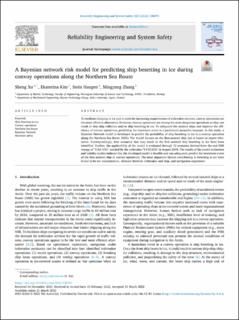| dc.contributor.author | Xu, Sheng | |
| dc.contributor.author | Kim, Ekaterina | |
| dc.contributor.author | Haugen, Stein | |
| dc.contributor.author | Zhang, Mingyang | |
| dc.date.accessioned | 2022-11-17T07:08:23Z | |
| dc.date.available | 2022-11-17T07:08:23Z | |
| dc.date.created | 2022-03-25T09:29:33Z | |
| dc.date.issued | 2022 | |
| dc.identifier.issn | 0951-8320 | |
| dc.identifier.uri | https://hdl.handle.net/11250/3032276 | |
| dc.description.abstract | To facilitate shipping in ice and to meet the increasing requirements of icebreaker services, convoy operations are the most effective alternative. However, convoy operations are among the most dangerous operations as they can result in ship-ship collisions and/or ship besetting in ice. To safeguard the assisted ships and improve the efficiency of convoy operations, predicting the besetment event is a paramount proactive measure. In this study, a Bayesian Network model is developed to predict the probability of ship besetting in ice in a convoy operation along the Northern Sea Route (NSR). The model focuses on the first-assisted ship and is based on expert elicitation. Correspondingly, four scenarios that may result in the first assisted ship besetting in ice have been identified. Further, the applicability of the model is evaluated through 12 scenarios derived from the real NSR voyage of ‘TIAN YOU’ assisted by the icebreaker ‘VAYGACH’ in August 2018. The results of the model evaluation and validity studies indicate that the developed model is feasible and can adequately predict the besetment event of the first assisted ship in convoy operations. The most important factors contributing to besetting in ice were found to be ice concentration, distance between icebreaker and ship, and navigation experience. | en_US |
| dc.language.iso | eng | en_US |
| dc.publisher | Elsevier | en_US |
| dc.rights | Navngivelse 4.0 Internasjonal | * |
| dc.rights.uri | http://creativecommons.org/licenses/by/4.0/deed.no | * |
| dc.title | A Bayesian network risk model for predicting ship besetting in ice during convoy operations along the Northern Sea Route | en_US |
| dc.type | Journal article | en_US |
| dc.type | Peer reviewed | en_US |
| dc.description.version | publishedVersion | en_US |
| dc.source.volume | 223 | en_US |
| dc.source.journal | Reliability Engineering & System Safety | en_US |
| dc.identifier.doi | https://doi.org/10.1016/j.ress.2022.108475 | |
| dc.identifier.cristin | 2012450 | |
| cristin.ispublished | true | |
| cristin.fulltext | original | |
| cristin.qualitycode | 2 | |

